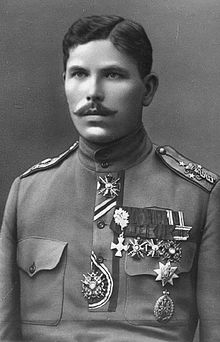Julius Kuperjanov
Julius Kuperjanov | |
|---|---|
 Julius Kuperjanov | |
| Born | 11 October 1894 Lyokhovo, Dukhnovo parish, Pskov Governorate, Russian Empire |
| Died | 2 February 1919 (aged 24) Tartu, Estonia |
| Place of burial | |
| Allegiance | |
| Service/ | Army |
| Years of service | 1914–1917 Imperial Russian Army 1918-1919 Estonian Army |
| Rank | Lieutenant |
| Unit | Tartumaa Partisan Battalion |
| Battles/wars | World War I Estonian War of Independence |
| Awards | Order of St. Anna II, III, IV degree Cross of St. George IV degree Order of Vladimir IV degree Order of Stanislav II, III degree Cross of Liberty (Estonia) (VR I/2, VR II/2 and II/3; posthumously) |
Julius Kuperjanov VR I/2, VR II/2 and VR II/3 (11 October [O.S. 29 September] 1894 – 2 February 1919) was an Estonian military officer during the War of Independence and commander of the Tartumaa Partisan Battalion renamed after him posthumously.
Life[]
Kuperjanov was a schoolteacher in the village of Kambja. At the start of World War I, he was mobilised into the Imperial Russian Army and commissioned after receiving basic officer training. He was wounded in both legs.
In 1917 he joined the Estonian forces during the start of the War of Independence. In December 1918, he received permission to form a ranger battalion. Students were among the first to join the Tartu County Partisan Battalion.
On 14 January 1919, Julius Kuperjanov was among the liberators of Tartu. He died some weeks later of wounds received leading an attack during the decisive Battle of Paju.
Family name[]
Because his parents emigrated to Russia for work, they acquired a russified form of their family name (original Kupper). After returning to Estonia, they preserved this name.[1]
Contemporary view[]

To honour Kuperjanov, the unit he had raised was renamed after him.[2] It was disbanded in 1940 after the Soviet occupation and re-established after Estonia regained its independence from the Soviet Union.[3]
Julius Kuperjanov was posthumously awarded the Cross of Liberty (VR I/2, VR II/2 and II/3). His tomb at the Raadi cemetery, Tartu, was one of the few War of Independence monuments to survive the Soviet occupation. The monument was restored in 2008. During the Soviet occupation of Estonia from 1940 to 1991, Kuperjanov's tomb acquired great symbolic significance. Dissidents and patriotically minded students would periodically gather there on various anniversaries to light candles and place flowers in his memory. During the occupation period, the KGB kept a watch on the tomb, and arrested the persons who came to honor the memory of the national hero.
Stamp issue[]
This section needs expansion. You can help by . (December 2009) |
In 2009, a commemorative stamp was issued to mark the 90th anniversary of Kuperjanov's death by Eesti Post.
See also[]
References[]
- ^ http://www.virumaa.ee/2008/01/ve-kuperjanov-julius/
- ^ Traksmaa, August: Lühike vabadussõja ajalugu, page 109. Olion, 1992
- ^ Eesti Kaitsevägi:Kuperjanovi Üksik-jalaväepataljon Archived 2007-10-11 at the Wayback Machine
External links[]
- PARTISANIDE PATALJONI ÜLEM LEITNANT JULIUS KUPERJANOV(in Estonian)
- Leitnant Julius Kuperjanov (in Estonian)
- 1894 births
- 1919 deaths
- People from Opochetsky District
- People from Pskov Governorate
- Russian military personnel of World War I
- Estonian military personnel of the Estonian War of Independence
- Recipients of the Cross of St. George
- Recipients of the Order of St. Vladimir, 4th class
- Recipients of the Order of St. Anna, 2nd class
- Recipients of the Order of St. Anna, 3rd class
- Recipients of the Order of St. Anna, 4th class
- Recipients of the Order of Saint Stanislaus (Russian), 2nd class
- Recipients of the Order of Saint Stanislaus (Russian), 3rd class
- Burials at Raadi cemetery
